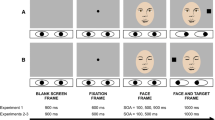Summary
The differential influence of fixation and directed visual attention on reaction times of goal-directed saccades and especially on the occurrence of express saccades was investigated.
In all the experiments the subjects were instructed first to keep their direction of gaze at the center of a translucent screen with or without a central fixation point. When a new stimulus appeared, the subjects had to look at it as soon as possible. In some control experiments the subjects had to direct their gaze to the screen center and simultaneously direct their attention to a peripheral light spot before the target for the saccade appeared.
Many express saccades occurred when either active fixation of a central fixation point or attention directed to a peripheral visual target (regardless of its position) was interrupted 200 ms before the target for the saccade appeared.
Express saccades were almost completely abolished in the presence of fixation and/or directed visual attention at the moment in which the saccade target appeared.
We conclude that express saccades occur if visual attention has already been released at the moment when the target for the saccade appears. This disengagement needs some time which adds to the reaction time.
Similar content being viewed by others
References
Boch R, Fischer B (1986) Further observations on the occurrence of express-saccades in the monkey. Exp Brain Res (submitted)
Boch R, Fischer B, Ramsperger E (1984) Express-saccades of the monkey: reaction times versus intensity, size, duration, and eccentricity of their targets. Exp Brain Res 55:223–231
Bruce CJ, Goldberg ME (1984) Physiology of the frontal eye fields. Trends Neurosci 7:436–441
Bushnell MC, Goldberg ME, Robsinson DL (1981) Behavioral enhancement of visual responses in monkey cerebral cortex. I. Modulation in posterior parietal cortex related to selective visual attention. J Neurophysiol 46:755–772
Fischer B, Boch R (1983) Saccadic eye movements after extremely short reaction times in the monkey. Brain Res 260:21–26
Fischer B, Boch R (1985) Peripheral attention versus central fixation: modulation of the visual activity of prelunate cortical cells of the rhesus monkey. Brain Res 345:111–123
Fischer B, Ramsperger E (1984) Human express-saccades: extremely short reaction times of goal directed eye movements. Exp Brain Res 57:191–195
Fischer B, Ramsperger E (1986) Human express-saccades: effects of daily practice and randomization. Exp Brain Res (submitted)
Fischer B, Boch R, Ramsperger E (1984) Express-saccades of the monkey: effects of daily training on probability of occurrence and reaction time. Exp Brain Res 55:232–242
Gauthier GM, Volle M (1975) Two dimensional eye movement monitor for clinical laboratory recordings. Electroencephalogr Clin Neurophysiol 39:285–291
Goldberg ME, Bushnell MC (1981) Behavioral enhancement of visual responses in monkey cerebral cortex. II. Modulation in frontal eye fields specifically related to saccades. J Neurophysiol 46:773–787
Guitton D, Buchtel HA, Douglas RM (1985) Frontal lobe lesions in man cause difficulties in suppressing reflexive glances and in generating goal-directed saccades. Exp Brain Res 58:455–472
Lynch JC, Mountcastle VB, Talbot WH, Yin TCT (1977) Parietal lobe mechanisms for directed visual attention. J Neurophysiol 40:362–389
Mountcastle VB, Lynch JC, Georgopoulos A, Sakata H, Aguna C (1975) Posterior parietal association cortex of the monkey: command functions for operations within extrapersonal space. J Neurophysiol 38:871–908
Posner MI, Walker JA, Friedrich FJ, Rafal RD (1984) Effects of parietal injury on covert orienting of attention. J Neurosci 4:1863–1874
Robinson DL, Goldberg ME, Stanton GB (1978) Parietal association cortex in the primate: sensory mechanisms and behavioral modulations. J Neurophysiol 41:910–932
Sakata H, Shibutani H, Kawano K (1980) Spatial properties of visual fixation neurons in posterior parietal association cortex of the monkey. J Neurophysiol 43:1654–1672
Saslow MG (1967) Effects of components of displacement-step stimuli upon latency of saccadic eye movements. J Opt Soc Am 57:1024–1029
Schiller PH, Sandell JH (1983) Interactions between visually and electrically elicited saccades before and after superior colliculus and frontal eye field ablations in the rhesus monkey. Exp Brain Res 49:381–392
Shibutani H, Sakata H, Hyvaerinen J (1984) Saccade and blinking evoked by microstimulation of the posterior parietal association cortex of the monkey. Exp Brain Res 55:1–8
Sparks DL, Mays LE (1983) Spatial localization of saccade targets. 1. Compensation for stimulation-induced perturbations in eye position. J Neurophysiol 49:45–63
Author information
Authors and Affiliations
Rights and permissions
About this article
Cite this article
Mayfrank, L., Mobashery, M., Kimmig, H. et al. The role of fixation and visual attention in the occurrence of express saccades in man. Eur Arch Psychiatr Neurol Sci 235, 269–275 (1986). https://doi.org/10.1007/BF00515913
Received:
Issue Date:
DOI: https://doi.org/10.1007/BF00515913




